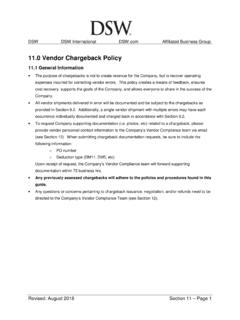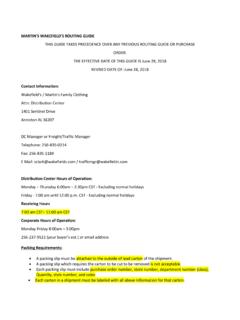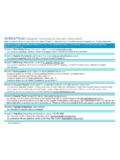Transcription of Gartner - as.ideascp.com
1 1 Gartner rpe2 Methodology OverviewIntroduction 2 rpe2 Background 3 rpe2 Definition 3 rpe2 Workload Extensions 4 Recommended Uses for rpe2 5 Server Consolidation Projects 6 Server Purchase Assessments 7 Filling in Benchmark Gaps 7 Chargeback 7 Conclusion 7 Industry Benchmarks 8 Contents1 Among the Gartner research and advisory products are tools to help clients understand and compare various characteristics of server systems, including pricing, features and performance. Our server performance estimates are powered by a methodology called Relative Performance Estimate 2 ( rpe2 ). rpe2 provides rapid approximate assessments of relative server performance. These performance estimates aid in comparing servers, making server recommendations or purchase decisions, analyzing server consolidation and technology refresh scenarios, capacity planning, and defining chargeback valuations.
2 This overview serves as an important reference for users of rpe2 . It explains how the performance estimates are derived and how they can be utilized. Ideas International was acquired in 2012 by Gartner , Inc. The acquisition includes proprietary methodologies such as rpe2 Methodology Overview2 IntroductionComparing the performance of computer systems can be a difficult task. Unlike most other high- technology and mass consumer products, servers have little objective information available to help users quantify performance capabilities in absolute or relative terms. Server manufacturers are not obligated to provide standardized performance data on products, as they are with power characteristics. In the absence of mandatory standards for specifying server performance, the IT industry has evolved a number of performance benchmarks. Some of these benchmarks are regulated by industry consortiums, others are created by individual hardware or software vendors, and still others are created by third-party companies or individuals.
3 Benchmarks vary in terms of the workloads simulated, the runtime complexity involved, the system characteristics measured and the rules applied for testing and reporting results. Users who require performance estimates often find available benchmark results inadequate. Common reasons for this inadequacy include: Data is not available for the specific product(s) users wish to evaluate. Data that is available focuses on only a subset of system performance or does not reflect the workload(s) users intend to run. Data is only available from a source with a possible conflict of interest, such as a seller promoting the purchase of a specific product. The chances that relevant benchmark data will not be found are greater when users are trying to compare servers from different manufacturers, different architectures or different generations.
4 In the absence of comprehensive, relevant and comparable data from manufacturers, we created a theoretical performance estimate called rpe2 . The objective of rpe2 is to provide users with comparable performance information for server products. rpe2 accomplishes this by incorporating the following: A composite workload profile Coverage of all x86, IA-64 and RISC server variants from the leading global manufacturers Coverage of current and obsolete server models rpe2 is a theoretical performance estimate and not an actual observed measurement of server performance. It is largely based on published benchmark results and relative performance ratings from server manufacturers. 3 Like any single metric, rpe2 can provide useful information, but it can also be misapplied. Later in this document we will be discussing recommended ways of using the relative performance data as support for server selection or for various aspects of operational planning.
5 rpe2 BackgroundThe original performance ranking data for enabling architecture-independent server comparisons was introduced in the late 1990s. This ranking series, known as RPE, was based purely on a single lightweight online transaction processing (OLTP) workload. The focus on a single benchmark workload presented a number of limitations and risks. So in order to better represent and expand the wide breadth of workloads and software stacks being deployed on servers and to increase the pool of reference benchmark data points, a composite benchmark methodology was initiated. In 2005, the new enhanced ranking methodology, rpe2 , was introduced as the replacement performance ranking series for server comparisons and consolidation Definition rpe2 is a composite benchmark, meaning that server performance characteristics are captured and calibrated against multiple workload profiles represented by a mix of industry benchmarks that have the widest technology coverage.
6 The published or estimated performance points for each server processor option are aggregated by calculating a geometric mean value. In the standard rpe2 , all components are weighted equally to prevent rpe2 from skewing toward a single benchmark or workload type. Other weighting options are described below. A composite mix benchmark offers the following advantages: The multiple components represent a broader range of workloads and server architecture characteristics. Multiple components enable the impact of benchmark life cycles to be managed in a less disruptive manner; benchmark substitution can be handled within the existing framework, and the overall spectrum of results can be kept broadly consistent. Multiple components increase the likelihood that more absolute performance values contribute directly to the composite. Multiple components enable the incorporation of additional components and mitigate the enforced loss of a single component.
7 4 The initial rpe2 benchmark set was selected from all available industry and ISV benchmarks based on how complete their coverage was for the major manufacturers and server architectures, and the extent of their published results. The current rpe2 set includes the following six benchmark inputs in its calculation: SAP SD Two-Tier, TPC-C, TPC-H, SPECjbb2015, and two SPEC CPU2006 components. As additional performance points for missing technologies appear in other existing benchmarks, or if new industry benchmarks are developed that potentially satisfy our selection criteria, they will also be considered for inclusion within the rpe2 composite. The primary objective for rpe2 is to reflect benchmarked server family relationships and vendor ranking data on a benchmark component-by-component basis. The rpe2 calculation process extrapolates and interpolates the best-case performance data from multiple benchmark sources, including relative performance data provided by server manufacturers.
8 By representing a broader spectrum of measured outcomes, the rpe2 values are more representative of overall server capability and the range of applications now being consolidated on virtualized server environments. The rpe2 performance rankings are designed to provide users with the most accurate and comprehensive coverage of available server performance. rpe2 data covers all processor configuration options for x86, IA-64 and RISC servers for major vendors from 1997 onward over 33,000 configurations in all. rpe2 also has several other virtues not found in any other performance-ranking data: Independence. rpe2 was developed and is maintained by an independent analyst company. Transparency. rpe2 is the only composite benchmark mix that is fully documented. Comprehensiveness. rpe2 is the only composite ranking that incorporates multiple workload types and covers all major technologies and architectures, including virtual machine types and public cloud servers.
9 Durability. rpe2 is designed to adapt to the availability and life cycle of the individual benchmark components; rpe2 continues even when constituent benchmarks change, become obsolete or are replaced. rpe2 Workload ExtensionsIn 2010, rpe2 was expanded to include Workload Extensions. Workload Extensions use different weightings of the constituent benchmark components of rpe2 in order to highlight performance within specific workload profiles. The following rpe2 Workload Extensions were created: rpe2 -ERP, highlighting the SAP SD Two-Tier component rpe2 -Java, highlighting the SPECjbb2015 component rpe2 -OLTP, highlighting the TPC-C component rpe2 -Compute-Intensive, highlighting the SPEC CPU2006 components 5 While rpe2 provides a readily accessible, inclusive and convenient measure of server performance, quantitative benchmarking of specific workloads on target servers will likely provide higher accuracy than rpe2 in terms of predicting performance.
10 We recommend that, when they exist, users should utilize workload- or application-specific performance benchmarks over rpe2 to estimate the performance of those workloads on specific servers. Before reviewing rpe2 usage in more detail, rpe2 should be placed into the context of its primary sources. Because rpe2 values are mainly derived from benchmarks and other information provided by manufacturers, the caveats that the manufacturers apply to their own performance data must also apply to rpe2 . Therefore, the following cautionary statements apply to rpe2 : The source data may include manufacturer performance rankings, which are largely based on estimates rather than actual performance measurements. rpe2 and rpe2 Workload Extensions are based on benchmarks that include a mix of workloads with different characteristics, and these may not be representative of a user s intended workload.





